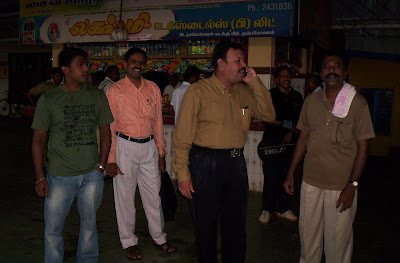Subscribe to:
Post Comments (Atom)
WORLD CLOCK
my birth day
Unit Converter
Difference between OPC & PPC cement
What is OPC Cement?
OPC means Ordinary Portland Cement which contains mixture of portland clinker and Gypsum ground to a very fine powder.
What is PPC Cement?
PPC means Portland Pozzolana Cement. It is manufactured by blending a mixture of Ordinary Portland cement and Pozzolana materials such as Fly Ash, in proportions not less than 15% and not more than 35% by weight of cement. The fineness of PPC will be greater than OPC.
What is the difference between OPC and PPC Cement?
Addition of Pozzolanic material such as fly ash in the cement manufacture by 15% to 35% is the only difference between OPC and PPC.
What are preferable constructions by OPC and PPC?
OPC: OPC is categorised as 33 Grade, 43 Grade and 53 Grade. It is preferably used in Defence Services, Railway Sleeper making and in lean concrete structures.PPC: PPC is having better resistance to Sulphate attack and hence it is preferably used in Sea Shore, Dam constructions and in the earth work concreting to neutralise corrosion effect of soil and water under the earth's crest. Due to higher fineness, mostly it is used in plastering work for smooth finishing.
.
What are the duration of curing for OPC and PPC?
Duration for curing is same for both OPC and PPC. But the water cement ratio may be slightly varied. As the cement is attaining full strength at 28 days, concretes made out of both the cements are to be cured for 28 days.
What is the method of curing for OPC and PPC?
Method of curing is identical for both OPC and PPC. A slightly higher humidity has to be created around the cement construction (by poring water) so as to allow the water content of cement mortar/concrete is ready for hydration reaction upto 28 days, the time required to attain full strength.
.
What is percentage of sand mixing for OPC and PPC?
Sand mixing in OPC or PPC is at different level depending upon the nature of mortar/concrete works. Some of the specialised concreting works, the addition of sand is restricted in PPC when compared to OPC.
What are the setting time for OPC and PPC?
Same for both OPC and PPC. i.e. initial setting time 30 minutes and final setting time 600 Minutes. (10 hours)
What is the difference between 43 and 53 Grade?
Both differs in terms of compressive strength as per details given below
TIME
43 GRADE
53 GRADE
A. 3 Days Strength
23 Mpa (min)
27 Mpa (min)
B. 7 Days Strength
33 Mpa (min)
37 Mpa (min)
C. 28 Days Strength
43 Mpa (min)
53 Mpa (min)
The differences are due to change in the potential phase composition of the clinker. The heat of hydration of 43 Grade is less than 53 Grade.
Why there is no grade for PPC?
Since gradation of cement is mainly due to the difference in potential phase composition of clinker such as C2S, C3S, etc., the addition of Pozzolana to cement manufactured will not hold good for any cement gradation for PPC. But PPC should meet out OPC 33 Grade strength on curing for 28 days as per BIS.
The difference between OPC & PPC is based on Fly ash content in the cement. PPC will have more fly ash content which adds fineness to cement. The setting time of the concrete will vary. PPC setting time shall be more than the OPC cement but the ultimate strength criteria will be same on sufficient curing time. PPC shall be used for non structural members such as plastering etc., which is much free from crack development as it takes gradual setting
What is the difference between TMT, HYSD, TOR steel?
What is the difference between TMT, HYSD, TOR steel?
Thermo Mechanically Treated (TMT) bars have revolutionised the industry with its superior quality as against the cold twisting process to manufacture the traditional reinforcement bars. The special heat treatment process ensures greater strength, excellent ductility, enhanced bendability and much superior weldability.
CHEMICAL PROPERTIES :
Grade C%Max* S%Max P%Max Mn%Min Si%Max
Fe-415 0.30 .055 .055 .55 .35
The most commonly used steel bar for concrete reinforcement is TOR steel. The other names of TOR steel are CTD bar, deformed steel bar, twisted steel bar, HSD bar, CWD bar etc. These TOR steel bars can be used for general concrete reinforcement in buildings, roads, bridges etc. These steel bars process a combination of strength and ductility that is far in excess of minimum limits specified in standard IS:1786.
::TOR steel bars are certified to IS:1786 in dimensional tolerances. However in the size range of 8/12 mm where tolerance are of great concern, much closer tolerance that the specification is maintained.
HYSD= High Yield Strength Deformed (steel) .It is reinfrocement steel.
Tor steel is HYSD. ie High Yield Strength Deformed bar.
As the name implies it has comparively high strength than Mild Steel.
They are graded as Fe415, Fe500 ie fy of 415 and 500 N/sqmm respectively.
the HYSD bars may be hot / cold worked.
TMT bar means thermo mechanically treated bar ie hot rolled steel wire is passed throgh cold water to make their suface harder as well as to keep the core softer. It serves two purposes corrosion resistance and weldability
Dinamalar.com | கடைசி செய்திகள்
NDTV News
NDTV News
sky walk

papu

my daughter

No comments:
Post a Comment